What’s Up?
Thanks to a post-Passover miracle, I was able to borrow a SONY a7R iii from B&H. It arrived on Thursday. I will be setting it up today — Friday May 3, 2019 — and using it at DeSoto. Will I love it? Time will tell. I am headed there today — two days early — to scout for IPT. It is not too late to join us with a healthy late registration discount. See below for details.
Do let us know your favorite of the four featured images and check out the Advanced Exposure Question below.
FlexShooter Pro
If you missed the news on the FlexShooter Pro, the great new counter-balanced gimbal/ballhead, check out the blog post here. We’ve sold nine over the first two days so just 11 left right now …
From early-purchaser Lana Hays via e-mail:
I am very impressed with the FlexShooter Pro system; it works even better than I thought it might!
New Micro-adjustment Procedure Follow-up via e-mail From Multiple IPT veteran Paul Reinstein
I can’t believe how much easier it is to run this microadjustment process at half the distance; all I can say is that i’m getting flat curves and tight clusters. thanks! Paul
If you missed it, you can learn more in the Micro-adjusting and Focus Fine-Tuning Made Way Easier Tip blog post here.
Still Desperate 🙂
I am desperately seeking one or two for the Galapagos Photo-Cruise of a Lifetime — no reasonable offer will be refused. And I am fervently hoping to sign up exactly one more photographer (male or female) for the UK Puffins, Gannets, and Red Kites IPT — with a large late-registration discount. And one or two more registrants the Fort DeSoto Short-Notice Sandbar Secrets IPT would make my day — please inquire about the late registration DeSoto discount via cell phone (863-221-2372) or e-mail.
Last Gatorland In-the-Field Sessions of the Season: Friday May 10 or Saturday May 11, 2019.
Join me at Gatorland this coming Saturday and learn a ton. It will be prime time for Cattle Egrets in breeding plumage, we might even have a shot at some Little Blue Herons, and there will still be lots of chicks of all sizes. There were still some nests with eggs on my last visit. Learn to shoot in the shade on sunny days! Most folks who visit Gatorland simply have no clue. Join me to learn how to photograph at easily accessible rookeries. An intermediate telephoto lens is all that you will need. Learn to think and see like a pro. A loaner FlexShooter Pro is available for either session.
Morning Session — 7-10am: $200.00
Morning Session with a 90-minute working lunch including image review and Photoshop: $300.00.
Selling Your Used Photo Gear Through BIRDS AS ART
Selling your used (or like-new) photo gear through the BAA Blog is a great idea. We charge only a 5% commission. One of the more popular used gear for sale sites charged a minimum of 20%. Plus assorted fees! Yikes. They went out of business. And e-Bay fees are now up to 13%. The minimum item price here is $500 (or less for a $25 fee). If you are interested please scroll down here or shoot us an e-mail with the words Items for Sale Info Request cut and pasted into the Subject line :). Stuff that is priced fairly — I offer pricing advice to those who agree to the terms — usually sells in no time flat. Over the past year, we have sold many dozens of items. Do know that prices on some items like the EOS-1D Mark IV, the old Canon 100-400, the old 500mm, the EOS-7D and 7D Mark II and the original 400mm DO lens have been dropping steadily. You can always see the current listings by clicking on the Used Photo Gear tab on the orange-yellow menu bar near the top of each blog post page.
Canon EOS-1DX Mark II dSLR Body (with extras!)
IPT veteran Mark Overgaard is offering a Canon EOS-1DX Mark II (< 53,000 actuations) in near-mint condition for the BAA record-low price of $3799.00. The sale includes the front body cap, a RRS L-plate, two LP-E19 Battery Packs, one previous generation battery, the LP-E4N, the LC-E19 Battery Charger, one SanDisk 64GB Extreme Pro CFast 2.0 card, the card reader with a compatible USB cable, the camera strap, the original box and user documents, and insured ground shipping via major courier to US lower 48 addresses only. Your item will not ship until your check clears unless other arrangements are made. Please contact Mark via e-mail.
The EOS-1DX is Canon’s flagship professional camera body. I made many fine images with mine. It is rugged and fast and features Canon’s best AF system. artie
Canon EOS 7D Mark II
IPT veteran Mark Overgaard is also offering a Canon EOS 7D Mark II (92,170 shutter count) in excellent plus to near-mint condition (but for a few small scratch marks on the rear LCD) for the BAA record-low price of $749.00. The sale includes the front body cap, a RRS L-plate, one LP-E6N Battery Pack, the battery charger, the camera strap, the original box and user documents, and insured ground shipping via major courier to US lower 48 addresses only. Your item will not ship until your check clears unless other arrangements are made.
Please contact Mark via e-mail.
The 7D Mark II is Canon’s top of the line crop factor body. If you doubt the image quality, do a search in the little white box on the top right of each blog post for “Dan Cadieux” or check out his incredible work in the Avian Forum on BirdPhotographer’s.Net. Or you can check out his opera-singing 7D II Virginia Rail image here. Not to mention that I made a slew of great images with this best-value-ever in a digital camera body … artie


Gear Questions and Advice
Too many folks attending BAA IPTs and dozens of photographers whom I see in the field and on BPN, are–out of ignorance–using the wrong gear especially when it comes to tripods and more especially, tripod heads… Please know that I am always glad to answer your gear questions via e-mail. Those questions might deal with systems, camera bodies, accessories, and/or lens choices and decisions.
|
|
|
This image was created on April 28, 2019, at Gatorland on my own. I used the hand held Sony FE 100-400mm f/4.5-5.6 GM OSS lens (at 400mm) and the beyond remarkable Sony Alpha a9 Mirrorless Digital Camera. ISO 640: 1/100 sec. at f/6.3 in Manual mode. Exposure determined by Zebras with ISO on the rear dial … AWB at 7:35am in the shade of a shelter). Expand Flexible Spot on the face of the closest bird. Image #1: Snowy Egret — two unfledged chicks near the nest |
SONY Image Stabilization
The combination of the OSS (Optical Steady Shot) technology in the 100-400 FE and the 5-axis SteadyShot INSIDE image stabilization in the a9 combine to minimize the appearance of camera shake when shooting handheld. — razor sharp at 1/000 second at 400mm is fairly impressive. Being able to work at relatively slow shutter speeds enables you to avoid using higher than desirable ISOs.
|
|
|
This image was also created on April 28, 2019, at Gatorland on my own. I used the hand held Sony FE 100-400mm f/4.5-5.6 GM OSS lens, the Sony FE 1.4x teleconverter (at 560mm), and the beyond remarkable Sony Alpha a9 Mirrorless Digital Camera. ISO 1000: 1/200 sec. at f/9 in Manual mode. AWB at 9:23am in the shade of the same shelter). Expand Flexible Spot on the bird’s right eye. Image #2: Snowy Egret large unfledged chick looking coy |
Snowy Egret Chick Bill Color Variation
Note that the bill color on all three Snowy Egret chicks in Image #1 and Image #2 is different. Such differences are related both to age and to individual variation. With chicks 2-4 weeks old separating Snowy Egret chicks from Little Blue Heron chicks is difficult to impossible. Separating those chicks from Cattle Egret chicks is more do-able as the bills of Cattle Egret at this stage are almost always solidly black and a bit thicker than the bills of the other two species. In addition, the heads of Cattle Egret chicks are always a bit blocky giving them a of square-headed look. As is usual, I noted only a very few Little Blue Heron nests on my last visit to Gatorland. It was quite unusual that although there were lots of Cattle Egrets setting up, I did not see a single nest with or without eggs.
|
|
|
This image was also created on April 28, 2019, at Gatorland on my own. I used the hand held Sony FE 100-400mm f/4.5-5.6 GM OSS lens (at 400mm) and the beyond remarkable Sony Alpha a9 Mirrorless Digital Camera. ISO 640: 1/200 sec. at f/6.3 in Manual mode. Exposure determined by Zebras with ISO on the rear dial … AWB at 7:32am with the bird in the shade of a shelter). Expand Flexible Spot on the bird’s eye. Image #3: Great Egret, large unfledged chick |
The SONY Exposure Advantage
Those using the Zebra function with SONY mirrorless cameras have a huge advantage over the rest of the world when it comes to quickly determine the best exposure. The Zebras are far more valuable than the in-camera histogram as the histogram will shift left or right drastically with small change in the image design. I set my desired shutter speed and aperture for a given situation and then raise (or lower) the ISO using the rear thumb wheel until I see only a smattering of Zebras. I should have noted that Zebras are the equivalent of in-viewfinder blinkies; they are visible with a half-press of the shutter button before you make an image.
|
|
|
This image was also created on April 28, 2019, at Gatorland on my own. I used the hand held Sony FE 100-400mm f/4.5-5.6 GM OSS lens, the Sony FE 1.4x teleconverter (at 560mm), and the beyond remarkable Sony Alpha a9 Mirrorless Digital Camera. ISO 800: 1/160 sec. at f/9 in Manual mode. AWB at 9:33am in the shade of the same shelter). Expand Flexible Spot on the bird’s eye. Image #4: Great Egret large unfledged tight face detail |
SONY FE 100-400mm f/4.5-5.6 GM OSS Lens: Tight Quarters Chick Slayer …
SONY FE 100-400mm f/4.5-5.6 GM OSS lens is incredibly versatile when working at close quarters in varying lighting conditions. Adding the Sony FE 1.4x teleconverter to the mix only increases this great versatility by giving you an additional 160mm of reach. At 560mm you have an approximate magnification of 11.2X. Do note the incredible variety of framing in today’s four images. As noted above, getting the right exposure is a breeze whether you are working in bright or very dark conditions. And the .98 meter minimum focusing distance is deadly at close range.
Your Favorite
Which of today’s four featured images do you think is that strongest? Do leave a comment and let us know why you made our choice.
An Advanced Exposure Question
Which image represents the most difficult exposure challenge. Why?
|
|
|
Fort DeSoto in spring is rife with tame birds, many in full breeding plumage. Click on the composite to enjoy a larger version. Clockwise from upper left around to center: Laughing Gull landing on head of Brown Pelican, Laughing Gull in flight, Reddish Egret sunrise silhouette, Great Blue Heron with needlefish, Yellow-crowned Night Heron with ghost crab, Roseate Spoonbill, Sanderling in breeding plumage, and white morph Reddish Egret in glorious breeding plumage. |
The 2019 Fort DeSoto Short-Notice Sandbar Secrets IPT/Sunday May 5 through the morning session on Wednesday May 8, 2019: 3 1/2 DAYS: $1649. Limit 4/Openings: 2. Meet and greet at 7PM on the evening of Saturday May 4.
Please inquire about the late-registration DeSoto discount via cell phone (863-221-2372) or e-mail.
Fort DeSoto, located just south of St. Petersburg, FL, is a mecca for a great variety of migrant shorebirds, gulls, terns, and passerines in Spring. Many of the gulls and terns will be courting and copulating. There the migrants join hundreds of Florida resident egrets, herons, night-herons, and pelicans on the T-shaped peninsula. We should get to photograph one of Florida’s most desirable shorebird species: Marbled Godwit. Black-bellied Plover and Willet are easy, American Oystercatcher almost guaranteed. Great Egret, Snowy Egret, Great Blue Heron, Tricolored Heron, and White Ibis are easy as well and many of those will be in their spectacular breeding plumages. Yellow-crowned Night-Heron is a strong possibility. We may get to see and photograph the amazing heron/egret hybrid that has been present for three years. And we should enjoy some great Brown Pelican flight photography. In addition, Royal, Sandwich, Forster’s, and Caspian Terns will likely provide us with some good flight opportunities as well. Though not guaranteed, Roseate Spoonbill and Wood Stork might well be expected. And we will be on the lookout for a migrant passerine fallout in the event of a thunderstorm or two. Yikes, I almost forgot to mention that nearly all of the birds are ridiculously tame!
|
|
|
Yes, Fort DeSoto in spring is rife with tame birds, most in breeding plumage. Click on the composite to enjoy a larger version. Clockwise from upper left around to center: breeding plumage Dunlin, dark morph Reddish Egret displaying, Laughing Gull vertical front-end portrait, Laughing Gull with prey item, landing on head of Brown Pelican, breeding plumage Royal Tern displaying, Royal Terns — pre-copulatory stance, Laughing Gulls copulating, Laughing Gull head portrait, breeding plumage Sandwich Tern with fish, and a rare treat, a breeding plumage White-rumped Sandpiper. |
Just some of the stuff you will learn …
On the IPT you will learn basics and fine points of digital exposure and to get the right exposure every time after making a single test exposure, how to approach free and wild birds without disturbing them, to understand and predict bird behavior, to identify many species of shorebirds, to spot the good situations, to choose the best perspective, to see and understand the light, and to design pleasing images by mastering your camera’s AF system. Most importantly you will surely learn to evaluate wind and sky conditions and understand how they affect bird photography. And you will learn how and why to work in Manual mode (even if you’re scared of it).
|
|
|
Again, Fort DeSoto in spring is rife with tame birds, most in breeding plumage. Click on the composite to enjoy a larger version. Clockwise from upper left around to center: Laughing Gull in flight, Yellow-crowned Night-Heron, Sandwich Terns copulating, Roseate Spoonbill, Great Egret with reflection, breeding plumage Short-billed Dowitcher, American Oystercatcher, Royal Tern, white morph Reddish Egret, and Snowy Egret in marsh. |
What we do
There will be seven shooting sessions in all: four 3+ hours morning session and three 2 1/2 hour afternoon sessions. There will be Photoshop/image review/critiquing sessions during lunch (lunch is included) on each of the three full days. That will be followed by Instructor Nap Time.
The best airport is Tampa (TPA). Once you register, you will receive an e-mail with the hotel/lodging information. Airport pick-up might be available as is riding with the leader. Combine those to avoid having to rent a car.
|
|
|
You got it, Fort DeSoto in spring is rife with tame birds, most in breeding plumage. Click on the composite to enjoy a larger version. Clockwise from upper left around to center: Roseate Spoonbill, immature Brown Pelican in flight, the heron/egret hybrid, American Oystercatcher feeding, immature Royal Tern on railing, Great Egret morning silhouette, Black Skimmer in surf, and underside head portrait of Great Blue Heron. |
Signing Up
A $500 deposit is due when you sign up and is payable by credit card. Balances must be paid by check after you register. Your deposit is non-refundable unless the IPT sells out with four folks so please check your plans carefully before committing. You can register by calling Jim or Jennifer during weekday business hours at 863-692-0906 with a credit card in hand or by sending a check as follows: make the check out to: BIRDS AS ART and send it via US mail here: BIRDS AS ART, PO BOX 7245, Indian Lake Estates, FL 33855. You will receive a confirmation e-mail with detailed instructions, clothing, and gear advice. Please remember that the meet and greet will take place on the evening of Saturday May 4. Please shoot me an e-mail if you plan to register or if you have any questions.
|
Folks attending this IPT will be out in the field early and stay late to take advantage of sunrise and sunset colors. Click on the composite to enjoy a larger version. Clockwise from upper left to center: Long-billed Curlew, juvenile Tricolored Heron, Marbled Godwits, Great Blue Heron, juvenile Pectoral Sandpiper, Wood Stork, smiling Sea Scallop, Ruddy Turnstone scavenging needlefish, Great Blue Heron sunset silhouette at my secret spot, and southbound migrant tern flock blur. |
Early and Late
Getting up early and staying out late is pretty much a staple on all BIRDS AS ART Instructional Photo-Tours; on this particular trip we will get lots of sleep as the days are short. Being in the field well before the sun comes up and staying out until sunset will often present unique photographic opportunities, opportunities that will be missed by those who need their beauty rest. I really love it when I am leaving the beach on a sunny morning after a great session just as a carful or two of well-rested photographers arrive.
If In Doubt …
If in doubt about using the BAA B&H affiliate link correctly, you can always start your search by clicking here. Please note that the tracking is invisible. Web orders only. Please, however, remember to shoot me your receipt via e-mail.




Please Remember to use my Affiliate Links and to Visit the New BAA Online Store 🙂
To show your appreciation for my continuing efforts here, we ask, as always, that you get in the habit of using my B&H affiliate links on the right side of the blog for all of your photo and electronics purchases. Please check the availability of all photographic accessories in the New BIRDS AS ART Online Store, especially the Mongoose M3.6 tripod head, Wimberley lens plates, Delkin flash cards and accessories, and LensCoat stuff.
As always, we sell only what I have used, have tested, and can depend on. We will not sell you junk. We know what you need to make creating great images easy and fun. And please remember that I am always glad to answer your gear questions via e-mail.
I would of course appreciate your using our B&H affiliate links for all of your major gear, video, and electronic purchases. For the photographic stuff mentioned in the paragraph above, and for everything else in the new store, we, meaning BAA, would of course greatly appreciate your business. Here is a huge thank you to the many who have been using our links on a regular basis and those who will be visiting the New BIRDS AS ART Online Store as well.
Be sure to like and follow BAA on Facebook by clicking on the logo link upper right.
Typos
In all blog posts and Bulletins, feel free to e-mail or to leave a comment regarding any typos or errors. Just be right :).

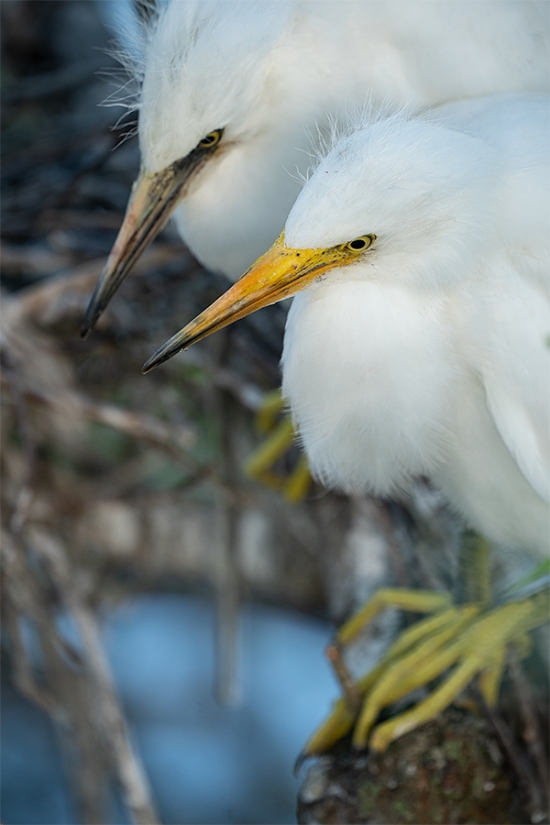
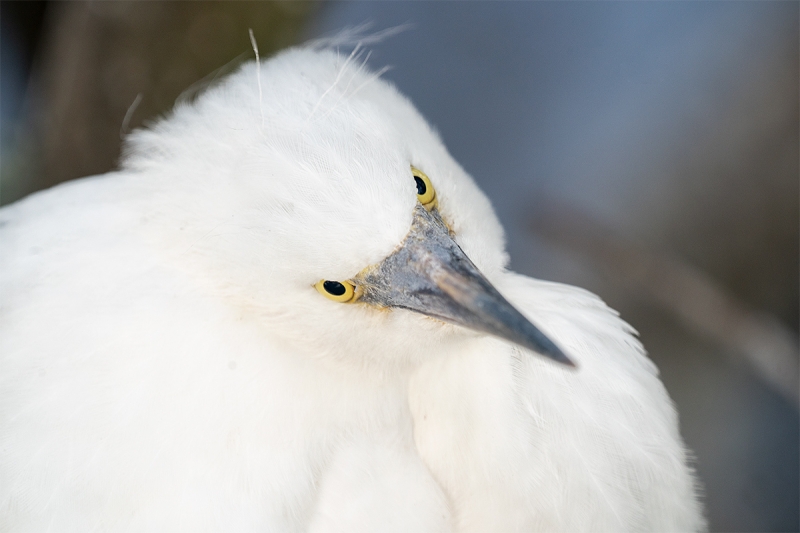
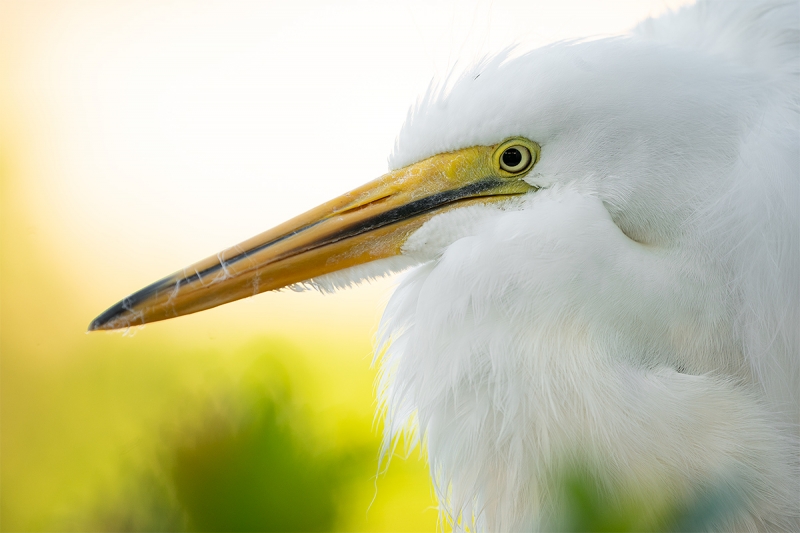
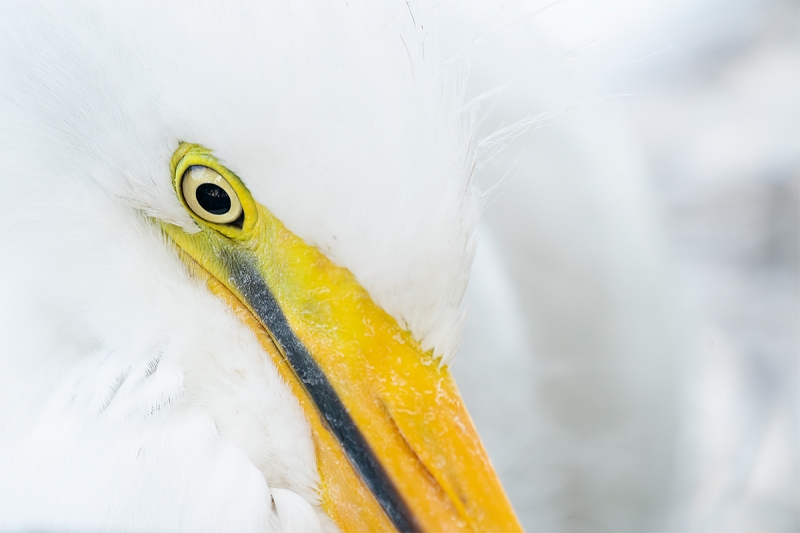
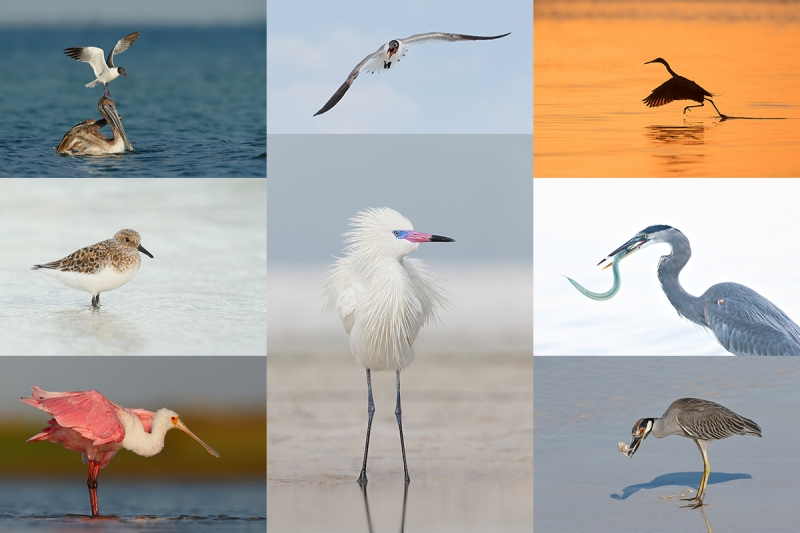
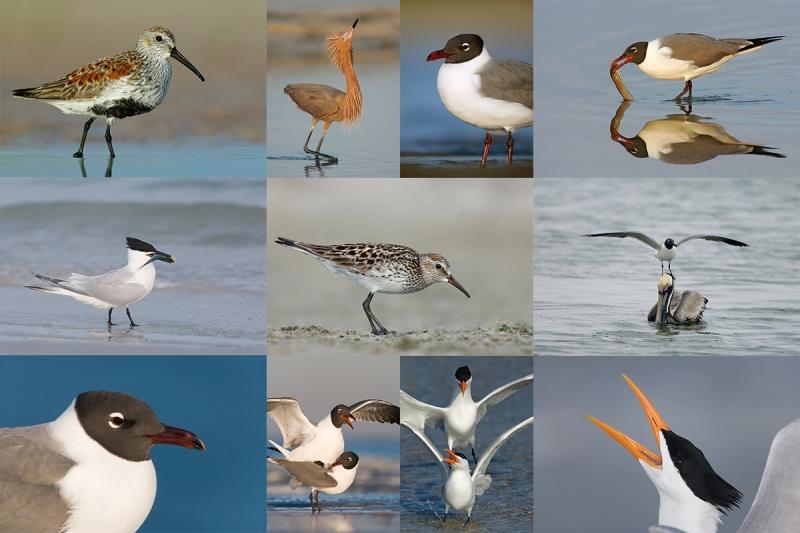
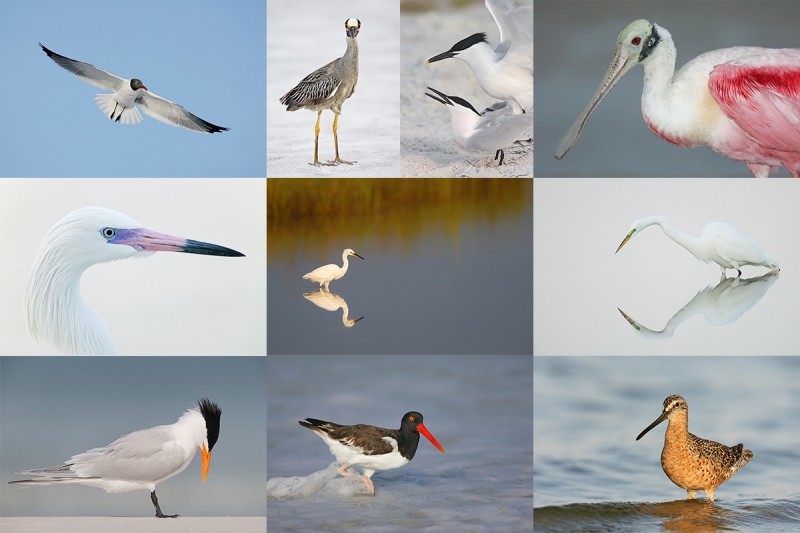
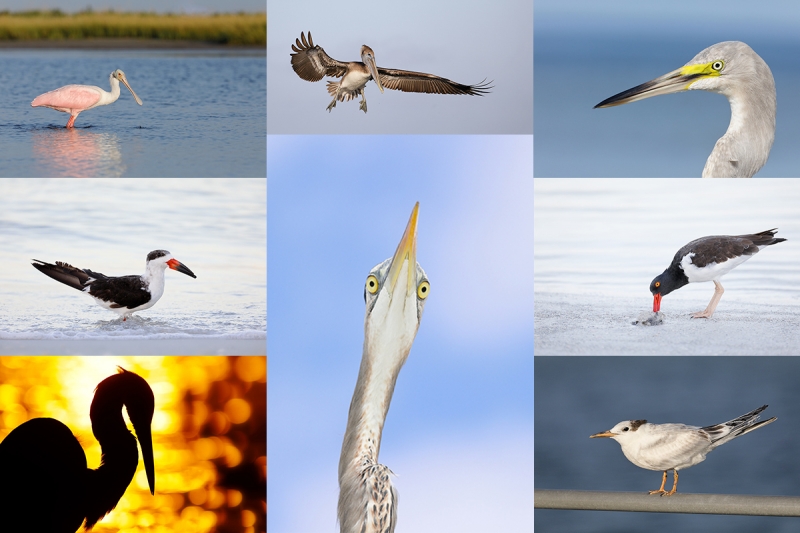














Hey Arthur, image #4 is my favorite. Nice tight graphic frame. That one says birds as art. I’m going with image #3 as the tougher exposure wise. The background across the top of the frame is quite bright.
I like 3 and 4 the best with 3 being my favorite. I know the meter in the Camera will see the white as grey, and so would overexpose the whites. So 3 with the brightest background was probably toughest to get the feather detail correct. 4 with so much white and seems to be more in the sun in the shade might have been tough to determine how much to open up. Thanks for teaching.
Looking back over the images again, I really like #3. I like the feather detail and the swirling pattern of the feathers!
Was so wrapped up in trying to figure out the exposure question I forgot this–
#1 is my favorite because the nearer bird is in sharp focus and the 2nd bird a little less. Also like seeing the bit of habitat with the lovely blue contrasting with the yellow bill.
Which image represents the most difficult exposure challenge. Why?
With what you say about “zebras” they were all easy.
But minus zebras, probably #1 would have been hardest because the image is about 1/2 white but the white is off to the side and not in the center. The other half is 1/2 dark making lots of contrast. That must have put the exposure at about 0 ? Then you darkened by about 1 1/3 stops to get detail in the essentially all white images #2 and #4 ?
I think I’d go with #3. I like the slightly less bright feather / texture. Composition and color are very nice as well. I do like the graphic appearance of #4, but #3 wins for me. All are images I would be proud to claim as mine.
All the best.
Very impressive, all of them, love the last one!
Thank you sir. I think that they are pretty neat too but I have a different favorite.
with love, artie
Interesting information about Sony. I hope they make a higher resolution version of the A9 and expand their lens lineup. In your paragraph titled “SONY Image Stabilization” you have a typo where you listed the shutter speed as 1/000.
Thanks for your comment Joel. Patrick loves his a7R iii even for flight. But SONY sure is missing a lot of telephotos, especially the longer focal lengths …
with love, artie
ps: I will be chiming in on the 7R iii here soon.